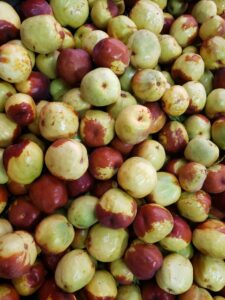Project Overview
Commodities
- Fruits: jujubes
Practices
- Crop Production: drought tolerance
- Education and Training: farmer to farmer
- Farm Business Management: budgets/cost and returns, e-commerce, farm-to-restaurant, marketing management
- Natural Resources/Environment: biodiversity
- Production Systems: organic agriculture
- Soil Management: soil quality/health
- Sustainable Communities: community development, ethnic differences/cultural and demographic change, leadership development, quality of life, social capital, social networks, sustainability measures, values-based supply chains
Proposal summary:
The research question that RFR seeks to answer is: "Will
increased education of the public regarding the health benefits
of jujubes result in increased sales and profit?"
Customers will be invited on social media to participate in
discussions on whether their purchases of jujubes have increased
as they learn more about the health benefits of the fruit. Jujube
nutrient information will be provided to inform the discussion.
The discussion results will inform RFR's marketing efforts.
The project is significant for the growth of the jujube industry
in California. In a normal rainfall year in the Cuyama Valley, no
irrigation is needed and fertilization requirements of jujubes
are very low. This drought tolerance is especially important in
this area which has been identified as "critically overdrafted"
by the Department of Water Resources (DWR). This means more water
has been pumped out of the ground than is replenished by
rainfall, stream flows, and other sources. According to the DWR
report, in an evaluation of the period from 1989 to 2009, the
Cuyama Valley is in "a basin subject to critical overdraft when
continuation of present water management practices would probably
result in significant adverse overdraft-related environmental,
social or economic impacts."
https://cuyamabasin.org/gw-sustainability
Jujube trees contribute to sustainable agriculture in part
because of their ability to prevent erosion. In turn, the land
surrounding the trees becomes an excellent habitat for
wildflowers that contribute to RFR's other crop, honey, which
increases our crop diversification.
Dissemination of information to producers will occur at the
California Rare Fruit Growers Conference, organic conferences,
social media, our e-newsletter, and in classes taught by Alisha
Taff at Allan Hancock College.
It is expected that this outreach will increase the number of
farmers who grow and market jujubes, as well as increase the
farmers' interest in sustainable agriculture.
Project objectives from proposal:
 Perfectly ripe fresh jujubes picked
Perfectly ripe fresh jujubes pickedand ready for distribution.[/caption]
RESEARCH: Marketing Research
Determine the effectiveness of disseminating health information
about jujubes to store buyers and the general public. Handouts
will be created, online discussions will be conducted, and
results will be published on social media platforms as well as in
our e-newsletter. Success will be measured by increase in sales.
EDUCATION:
Classes will be taught at Allan Hancock College to socially
disadvantaged students seeking to learn about income-producing
crops. Presentations and classes will be offered to farmers who
are interested in growing and marketing jujubes. The curriculum
will include history of this traditional crop, best varieties for
the Central California region, care of jujube trees, food safety
compliance, and pre- and post-harvest best practices for timely
harvesting, drying, storage and record-keeping.